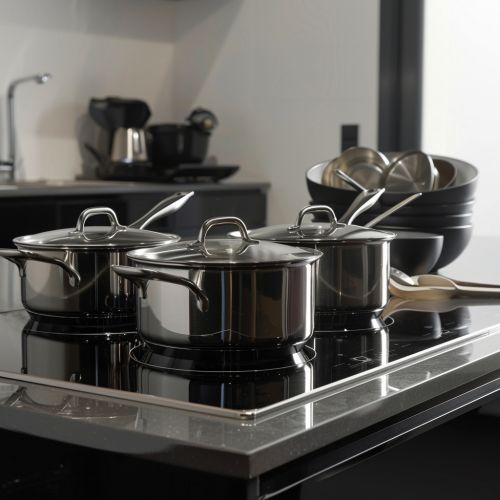Induction cooking
Introduction


Induction cooking is a method of cooking that uses electromagnetic induction to heat cookware directly, as opposed to traditional methods that use thermal conduction from a flame or an electric heating element. This technology has been gaining popularity due to its energy efficiency, safety features, and precise control over cooking temperatures.
Principles of Induction Cooking
Induction cooking relies on the principle of electromagnetic induction. When an alternating current passes through a coil of wire (the induction coil) beneath the cooking surface, it generates a fluctuating magnetic field. This magnetic field induces an electric current in the ferromagnetic cookware placed on the cooktop. The resistance of the cookware to this induced current generates heat, which cooks the food.
The efficiency of induction cooking is significantly higher than that of traditional gas or electric cooktops. This is because the heat is generated directly in the cookware, minimizing heat loss to the surrounding environment. Induction cooktops also offer rapid heating and precise temperature control, making them a preferred choice for professional chefs and home cooks alike.
Components of an Induction Cooktop
An induction cooktop typically consists of several key components:
Induction Coil
The induction coil is a copper wire coil located beneath the cooking surface. When an alternating current flows through this coil, it creates a magnetic field that induces an electric current in the cookware.
Ferromagnetic Cookware
For induction cooking to work, the cookware must be made of or contain a ferromagnetic material, such as cast iron or certain types of stainless steel. Non-ferromagnetic cookware, such as aluminum or copper, will not work unless they have a ferromagnetic layer.
Control System
The control system regulates the power supplied to the induction coil, allowing for precise control over the cooking temperature. Modern induction cooktops often feature touch-sensitive controls, digital displays, and programmable settings.
Cooling System
Induction cooktops generate heat not only in the cookware but also in the electronic components. To prevent overheating, these cooktops are equipped with cooling fans and heat sinks.
Advantages of Induction Cooking
Induction cooking offers several advantages over traditional cooking methods:
Energy Efficiency
Induction cooktops are highly energy-efficient, with up to 90% of the energy generated being used to heat the cookware. In comparison, gas and electric cooktops have efficiencies of around 40-55%.
Safety
Induction cooktops are safer to use because the cooking surface remains relatively cool. The heat is generated directly in the cookware, reducing the risk of burns. Additionally, induction cooktops often have safety features such as automatic shut-off and child locks.
Precision and Control
Induction cooktops provide precise control over cooking temperatures, allowing for more consistent and accurate cooking results. The rapid response time of induction heating means that temperature adjustments can be made almost instantaneously.
Easy to Clean
Since the cooking surface of an induction cooktop remains cool, spills and splatters do not burn onto the surface, making it easier to clean.
Limitations and Challenges
Despite its advantages, induction cooking also has some limitations and challenges:
Cookware Compatibility
Not all cookware is compatible with induction cooktops. Only ferromagnetic cookware can be used, which may require some users to replace their existing pots and pans.
Initial Cost
Induction cooktops are generally more expensive than traditional gas or electric cooktops. However, the long-term energy savings and efficiency may offset the initial investment.
Electrical Requirements
Induction cooktops require a significant amount of electrical power, which may necessitate upgrades to the electrical system in some homes.
Applications of Induction Cooking
Induction cooking is used in various settings, including:
Residential Kitchens
Induction cooktops are becoming increasingly popular in home kitchens due to their efficiency, safety, and ease of use.
Professional Kitchens
Many professional chefs prefer induction cooktops for their precise temperature control and rapid heating capabilities.
Portable Induction Cookers
Portable induction cookers are compact and convenient for use in small kitchens, dorm rooms, or outdoor settings.
Commercial and Industrial Applications
Induction cooking is also used in commercial and industrial settings, such as restaurants, catering services, and food processing plants.
Future Trends in Induction Cooking
The future of induction cooking looks promising, with ongoing advancements in technology and materials. Some potential trends include:
Smart Induction Cooktops
Integration with smart home systems and IoT (Internet of Things) technology could allow for remote control and monitoring of induction cooktops.
Enhanced Efficiency
Research and development efforts are focused on improving the efficiency and performance of induction cooktops, including the use of advanced materials and innovative designs.
Expanded Cookware Compatibility
New developments in cookware materials may expand the range of compatible cookware for induction cooktops, making them more accessible to a broader audience.
See Also
- Electromagnetic Induction
- Ferromagnetic Materials
- Energy Efficiency in Cooking
- Smart Home Technology
